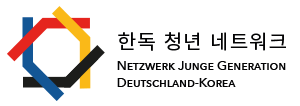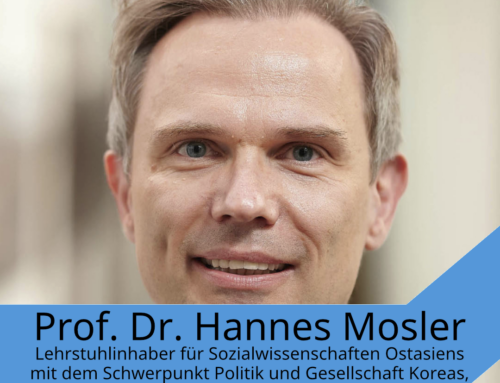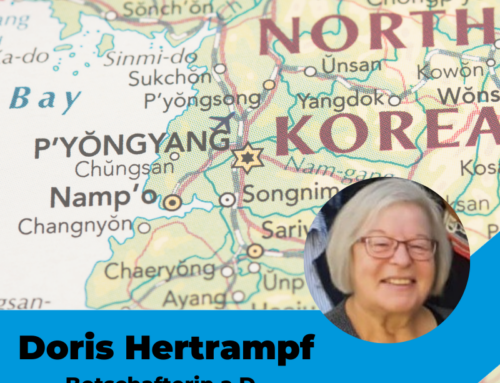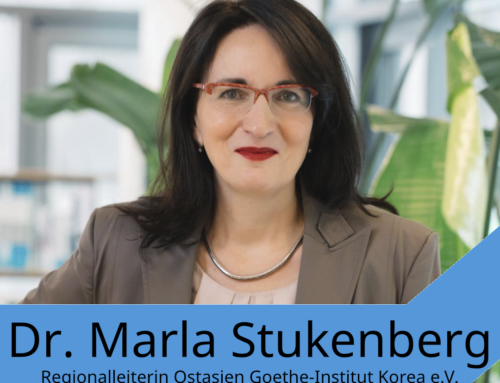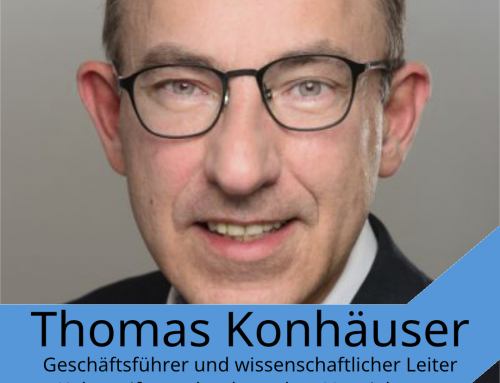Projekt Beschreibung
Die Fragen stellte Paul Schönewald, Arbeitsgruppe „10 Fragen an” des Netzwerks Junge Generation Deutschland-Korea.
Hinweis: Die Äußerungen unserer Interviewpartner stellen deren Meinung dar und spiegeln nicht grundsätzlich die Meinung des Deutsch Koreanischen Forums e.V. oder des Netzwerks Junge Generation Deutschland-Korea wider.
Das Interview wurde auf Englisch geführt. Das Original könnt ihr hier lesen.
- Why did you decide to become a Patent Attorney?
When I was working as research engineer of a large Korean corporation, I had opportunities to work with patent attorneys with regard to patent filing of my development work. At that time, I came to realize that the work of patent attorneys which turns a company’s Research and Development (R&D) work into intellectual property (IP) rights is probably the highest valued added work for anyone with a science and engineering background.
- How does your typical workday look like?
As a co-managing partner of an IP law firm, I begin my day by checking the progress of all pending tasks that should be monitored daily. When a new case is received, I discuss with my partners how the work should be assigned and distributed among the associates. Frequently, I advise directly or communicate via email with clients on various issues related to patent practice in Korea. Of course, I also participate in management-related meetings when necessary. Currently, I spend a large portion my working time in developing new domestic clients. This requires me to attend many on-line and off-line meetings with existing and potential new clients.
- According to the Korean Intellectual Property Office South Korea applied for 20,000 international patents in 2020, coming in fourth behind China, the United States and Japan. The aforementioned number has doubled within the last 10 years. What are the main reasons for this development?
Korea’s ratio of R&D spending with respect to GDP is among the highest in the world. Due to the lack of natural resources and limited market size, we have relied on technology development and export as the main engines of economic growth. The rapid increase in the number of international patent filings is the natural outcome of this technology development and export-oriented policy. The much publicized patent litigation between Samsung and Apple that started in 2011 also played a major role in raising awareness of the importance of patents in Korean companies.
- One of the working groups during the 8th German-Korean Juniorforum in 2018 recommended to introduce a global standardized patent classification system. Do you share this view?
Yes. I do. A patent classification is a hierarchical classification system used primarily to classify and assist searching of patent documents according to the technical features of their content. The Korea Intellectual Property Office (KIPO) has adopted the International Patent Classification (IPC) system along with more than 100 patent offices around the world. There are other classification systems used by the largest patent offices, namely the CPC system for EP and US and FI for Japan. A global standardized patent classification system is very important because it allows patent examiners and the public to search through international patent documents accurately and efficiently. Also, patent documents in different languages can easily be identified by using the codes of the system based on the patent classification.
- Are patents a burden or an opportunity for startups and Small and Medium Sized Enterprises (SME)?
Patents are a great opportunity for startups and SMEs. Not only does the Korean government have many schemes to support innovative companies with a strong IP portfolio, but they are also more likely to attract investment from established corporations or big investors.
- Which role do patents play within the Fourth Industrial Revolution?
Compared to previous industrial revolutions in which a patent was the foundation of a specific product, a patent in the Fourth Industrial Revolution will be at the heart of a whole network of new ideas and interconnected technologies that can have far-reaching implications on everyday life.
- The COVID19 pandemic has effected all business sectors. Has the pandemic also left an impact on issues related to intellectual property?
In 2020, the number of applications filed in Korea for IP rights such as patents, trademarks, and designs reached a record high of 557,229, which is an increase of 9.1% over 2019 (the highest increase since 2006). Thus, efforts to obtain IP rights in Korea actually increased despite the COVID-19 pandemic. The data shows that this increase mostly resulted from the increased filing activities of small and medium sized companies. Also, there has been a marked increase in patent filings in the technical areas related to contact-free technologies and healthcare technologies including remote healthcare, robots, personal hygiene, and vaccine development.
- Your professional network includes many German Patent Attorneys. In your opinion, what are the main differences between Korean and German Patent Attorneys?
A couple of differences that I have noiticed many times are that the German patent attorneys tend to be higly qualified academically and many of them have professional industry experince. However, rather differences, we actually have more similarities such as we both are hard working and enjoy drinking beers after work.
- You have studied overseas. Why did you decide to study abroad?
In my case, when I was young (16 years old) my family moved to London where my father was seconded to the UK branch of his company. Eventually my family returned back to Korea but I stayed on to continue my studies. I am always grateful for my father for the opportunity to live and study in an international city like London. I had a chance to learn English and experience the multicultural world at a relatively early phase of my life. This experience helped me to broaden my perspective and to enjoy working with various people around the world.
- Do you have any recommendations for tourist destinations or must-do activities in Korea for our German readers?
I strongly recommend any foreigners to visit the Namsan Tower at night (also daytime) as you can see a really nice panoramic view of Seoul. Changdeokgung Palace is my favorite among the five old palaces in Seoul because this palace was the beloved residence of many Kings and Queens and the well-preserved old buildings in the palace are surrounded by beautiful gardens (known as the Secret Gardens). Also, Bukchon Hanok Village which is home to hundreds of traditional houses, called Hanok, and Insa-dong, where you can taste various traditional Korean foods and shop for souvenirs are a short walking distance from the palace.
If you have more time to venture outside of Seoul, I would recommend Seoraksan National Park which is one of Korea’s most beautiful mountains located near the east coast city of Sokcho (160km from Seoul) and nearby Naksansa – a beautiful Buddhist temple right by the ocean.
- Warum haben Sie sich entschieden, Patentanwalt zu werden?
Als ich als Forschungsingenieur in einem großen koreanischen Unternehmen arbeitete, hatte ich Gelegenheit, mit Patentanwälten im Hinblick auf die Patentanmeldung meiner Entwicklungsarbeit zusammenzuarbeiten. Damals wurde mir klar, dass die Arbeit von Patentanwälten, die die Forschungs- und Entwicklungsarbeit (F&E) eines Unternehmens in Rechte an geistigem Eigentum (IP) umwandelt, wahrscheinlich die am höchsten bewertete Arbeit für jeden mit einem wissenschaftlichen und technischen Hintergrund ist.
- Wie sieht Ihr typischer Arbeitstag aus?
Als Co-Managing Partner einer IP-Kanzlei beginne ich meinen Tag damit, den Fortschritt aller anstehenden Aufgaben zu überprüfen, welche täglich überwacht werden sollten. Wenn ein neuer Fall eingeht, bespreche ich mit meinen Partnern wie die Arbeit zugewiesen und auf die Associates verteilt werden soll. Häufig berate ich Mandanten direkt oder kommuniziere per E-Mail mit ihnen über verschiedene Fragen im Zusammenhang mit der Patentpraxis in Korea. Natürlich nehme ich auch an Besprechungen des Managements teil, wenn es nötig ist. Derzeit verbringe ich einen großen Teil meiner Arbeitszeit mit der Entwicklung neuer inländischer Mandate. Dies erfordert, dass ich an vielen Online- und Offline-Meetings mit bestehenden und potenziellen neuen Mandanten teilnehme.
- Laut dem koreanischen Amt für geistiges Eigentum meldete Südkorea im Jahr 2020 20.000 internationale Patente an und lag damit an vierter Stelle hinter China, den Vereinigten Staaten und Japan. Die vorgenannte Zahl hat sich innerhalb der letzten 10 Jahre verdoppelt. Was sind die Hauptgründe für diese Entwicklung?
Koreas Verhältnis der F&E-Ausgaben zum BIP gehört zu den höchsten der Welt. Aufgrund des Mangels an natürlichen Ressourcen und der begrenzten Marktgröße haben wir uns auf die Technologieentwicklung und den Export als Hauptmotoren des Wirtschaftswachstums verlassen. Der rasante Anstieg der Zahl der internationalen Patentanmeldungen ist das natürliche Ergebnis dieser Technologieentwicklung und exportorientierten Politik. Der viel beachtete Patentrechtsstreit zwischen Samsung und Apple, der 2011 begann, spielte auch eine wichtige Rolle bei der Sensibilisierung für die Bedeutung von Patenten in koreanischen Unternehmen.
- Eine der Arbeitsgruppen während des 8. Deutsch-Koreanischen Juniorforums 2018 hat empfohlen, ein weltweit einheitliches Patentklassifikationssystem einzuführen. Teilen Sie diese Ansicht?
Ja, das tue ich. Eine Patentklassifikation ist ein hierarchisches Klassifizierungssystem, das in erster Linie dazu dient, Patentdokumente nach den technischen Merkmalen ihres Inhalts zu klassifizieren und die Suche zu unterstützen. Das koreanische Amt für geistiges Eigentum (KIPO) hat das System der Internationalen Patentklassifikation (IPC) zusammen mit mehr als 100 Patentämtern auf der ganzen Welt übernommen. Es gibt andere Klassifizierungssysteme die von den größten Patentämtern verwendet werden, nämlich das CPC-System für EP und USA und FI für Japan. Ein weltweit standardisiertes Patentklassifikationssystem ist sehr wichtig, weil es Patentprüfern und der Öffentlichkeit erlaubt, internationale Patentdokumente genau und effizient zu durchsuchen. Außerdem können Patentdokumente in verschiedenen Sprachen leicht identifiziert werden, indem die Codes des Systems auf der Grundlage der Patentklassifikation verwendet werden.
- Sind Patente eine Last oder eine Chance für Startups und kleine und mittlere Unternehmen (KMU)?
Patente sind eine große Chance für Startups und KMUs. Die koreanische Regierung hat nicht nur viele Programme, um innovative Unternehmen mit einem starken IP-Portfolio zu unterstützen, sondern es ist auch wahrscheinlicher, dass sie Investitionen von etablierten Konzernen oder großen Investoren anziehen.
- Welche Rolle spielen Patente innerhalb der Vierten Industriellen Revolution?
Im Vergleich zu früheren industriellen Revolutionen, in denen ein Patent die Grundlage für ein bestimmtes Produkt war, wird ein Patent in der Vierten Industriellen Revolution das Herzstück eines ganzen Netzwerks neuer Ideen und miteinander verbundener Technologien sein, die weitreichende Auswirkungen auf das tägliche Leben haben können.
- Die COVID19-Pandemie hat sich auf alle Unternehmensbereiche ausgewirkt. Hat die Pandemie auch Auswirkungen auf Fragen im Zusammenhang mit geistigem Eigentum hinterlassen?
Im Jahr 2020 erreichte die Anzahl der in Korea eingereichten Anmeldungen für IP-Rechte wie Patente, Marken und Designs ein Rekordhoch von 557.229, was einem Anstieg von 9,1 % gegenüber 2019 entspricht (der höchste Anstieg seit 2006). Somit haben die Bemühungen, IP-Rechte in Korea zu erhalten, trotz der COVID-19-Pandemie tatsächlich zugenommen. Die Daten zeigen, dass dieser Anstieg vor allem auf die verstärkte Anmeldetätigkeit von kleinen und mittleren Unternehmen zurückzuführen ist. Außerdem gab es einen deutlichen Anstieg der Patentanmeldungen in den technischen Bereichen, welche sich auf berührungslose Technologien und Gesundheitstechnologien beziehen, einschließlich Fernversorgung, Roboter, Körperpflege und Impfstoffentwicklung.
- Ihr berufliches Netzwerk umfasst viele deutsche Patentanwälte. Was sind Ihrer Meinung nach die Hauptunterschiede zwischen koreanischen und deutschen Patentanwälten?
Ein paar Unterschiede, die mir schon oft aufgefallen sind, sind, dass die deutschen Patentanwälte in der Regel akademisch hoch qualifiziert sind und viele von ihnen professionelle Industrieerfahrung haben. Aber statt der Unterschiede haben wir eigentlich mehr Gemeinsamkeiten, wie zum Beispiel, dass wir beide hart arbeiten und nach der Arbeit gerne ein Bier trinken.
- Sie haben im Ausland studiert. Warum haben Sie sich für ein Studium im Ausland entschieden?
In meinem Fall zog meine Familie, als ich jung war (16 Jahre alt), nach London, wo mein Vater in die britische Niederlassung seiner Firma entsandt wurde. Meine Familie zurück nach Korea. Ich blieb jedoch, um mein Studium fortzusetzen. Ich bin meinem Vater nach wie vor für die Möglichkeit dankbar, dass ich in einer internationalen Stadt wie London leben und studieren durfte. Ich hatte die Chance, Englisch zu lernen und die multikulturelle Welt in einer relativ frühen Phase meines Lebens zu erleben. Diese Erfahrung hat mir geholfen, meinen Blickwinkel zu erweitern und den Umgang mit verschiedenen Menschen aus aller Welt zu genießen.
- Haben Sie irgendwelche Empfehlungen für touristische Ziele oder Must-Do-Aktivitäten in Korea für unsere deutschen Leser?
Ich empfehle allen Ausländern dringend, den Namsan-Turm bei Nacht (auch tagsüber) zu besuchen, da man einen wirklich schönen Panoramablick auf Seoul sehen kann. Der Changdeokgung-Palast ist mein Favorit unter den fünf alten Palästen in Seoul, weil dieser Palast die geliebte Residenz vieler Könige und Königinnen war und die gut erhaltenen alten Gebäude im Palast von wunderschönen Gärten (bekannt als die Geheimen Gärten) umgeben sind. Auch das Hanok-Dorf Bukchon, das Hunderte von traditionellen Häusern, Hanok genannt, beherbergt, und Insa-dong, wo Sie verschiedene traditionelle koreanische Speisen probieren und Souvenirs einkaufen können, sind nur einen kurzen Fußweg vom Palast entfernt.
Wenn Sie mehr Zeit haben, um sich außerhalb von Seoul zu bewegen, würde ich den Seoraksan-Nationalpark empfehlen, der einen der schönsten Berge Koreas beheimatet und sich in der Nähe der Ostküstenstadt Sokcho (160 km von Seoul entfernt) befindet. Ebenfalls befindet sich dort der Naksansa – ein schöner buddhistischer Tempel direkt am Meer.
